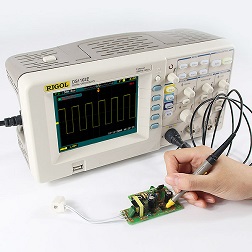How to calculate the bandwidth of the oscilloscope?

Oscilloscopes have many different specifications, which determine the accuracy of the signals that can be captured and measured. But the main specification of it is its bandwidth. Student experiment of electronic engineering uses oscilloscopes that may have enough bandwidth. The professor will assign it for most (if not all) experiments. When you finally complete the electronic engineering course and enter the electronics industry, you may need to select an oscilloscope from your company’s instrument pool to test your design, or your boss will committee you to evaluate various kind that you purchased. This bandwidth tutorial will provide you with some useful tips on how to choose it. But first, let’s define the oscilloscope bandwidth.
What is bandwidth? Definition of bandwidth
All oscilloscopes have a low-pass frequency response displayed at a higher frequency, as shown in the figure below. Most oscilloscopes with bandwidth specifications of 1 GHz and below usually have a Gaussian frequency response. The oscilloscope’s Gaussian frequency response is similar to a single-pole low-pass filter. That is, you may have learned something in some circuit courses and oscilloscope may draw them as a Bode plot.

Oscilloscope Gaussian frequency response
The lowest frequency at which the input signal is attenuated by 3 dB is regarded as the bandwidth (fBW) of the oscilloscope. Performing signal attenuation at a frequency of -3 dB will translate into an amplitude error of approximately -30%. In other words, if a 1 Vp-p, 100 MHz sine wave is input into a 100 MHz bandwidth oscilloscope, the peak-to-peak voltage measured with it will be about 700 mVp-p (-3 dB = 20 Log [0.707/1.0] ) In the range. Therefore, you cannot perform accurate measurements on signals with ultra-high frequencies around the oscilloscope’s bandwidth.
Closely related to the bandwidth specification of the oscilloscope is its rise time specification. The rise time of an oscilloscope is approximately 0.35/FBW (based on the 10% to 90% standard). However, you need to remember that it is not the fastest edge speed that the oscilloscope can accurately measure. But when the input signal has a theoretically infinitely fast rise time (0 ps), the fastest edge speed the oscilloscope can produce. Although from a practical point of view, we can not test this theoretical specification. You can test the rise of the oscilloscope by inputting pulses.
Do I need higher bandwidth?
Bandwidth: Bandwidth is the most important feature of the oscilloscopes.
In today’s era of digital oscilloscopes, we need higher bandwidth, not just analog amplifier bandwidth. To ensure that your oscilloscope has enough bandwidth to meet the application, you must fully consider the bandwidth of the signal that it will view.
Bandwidth is an important characteristic of an oscilloscope. It determines the range of the signal the oscilloscope displayed, which in turn will affect your purchase price. When deciding how much bandwidth to buy, you need to weigh the current budget constraints and the role that the oscilloscope will play during the life of the laboratory.

That is, the bandwidth is determined according to the needs of the application.
Looking at today’s digital technology, the system clock is usually the highest frequency signal that an oscilloscope needs to display. The bandwidth of your oscilloscope must be at least three times higher than this frequency to display these signals properly.
In addition, the rise time of the signal is also an important feature in the system. It has a great influence on the bandwidth of the oscilloscope. When you look at the signal, what you see is often harmonics in the basic signal. For example, when looking at a square wave, the signal contains a frequency that is over 10 times the fundamental frequency. When viewing signals, if we cannot guarantee the proper bandwidth, the oscilloscope display will show circular edges. The result will affect the measurement accuracy.
How can I determine how much bandwidth I need?
According to the following equation, you will be able to easily determine the appropriate oscilloscope bandwidth according to the signal characteristics:
- Signal bandwidth = 0.5 / signal rise time
- Bandwidth = 2 x signal bandwidth
- Real-time sampling rate = 4 x Bandwidth





